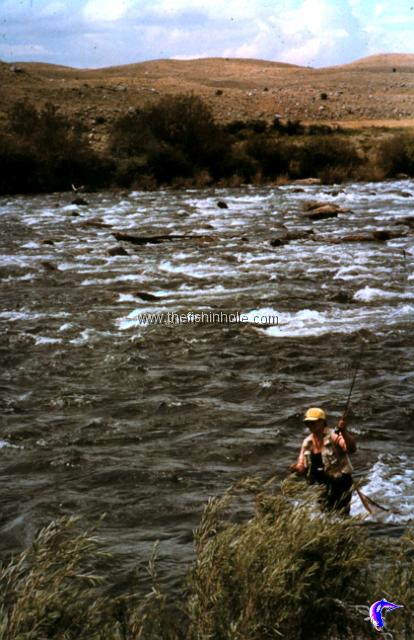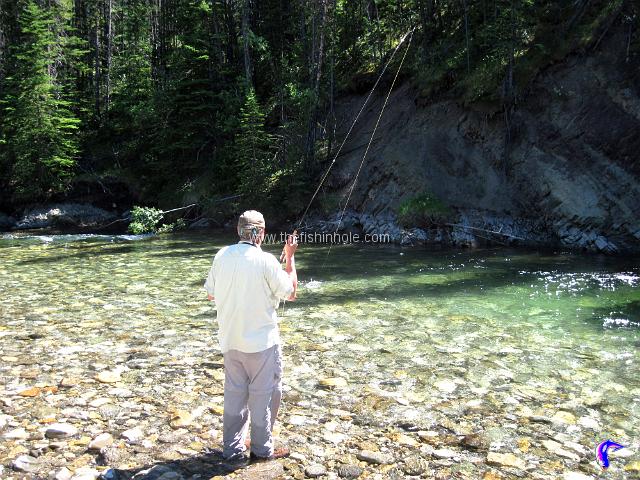Many angler's miss out on fishing opportunities because they are "fair weather fishermen", if weather or water conditions aren't quite right, they don't bother to go. On the other hand many anglers will face the worst of weather and water conditions just to get out. Many parts of the country faced extremely high water conditions this year, and southern Alberta was no exception. If a Bow River angler was waiting for the river to drop and clear before going angling this year, they would have missed out on many days of good fishing, and some of the best stonefly fishing in years. The combination of a cold wet spring, above average snow pack, weir reconstruction and some technical difficulties with turbines on one of the tributaries of the river caused high and off colour water for most of the year. What anglers have to realize is that the fish are still there and they still need to eat, so it is always possible to hook-up in all but the worst of conditions.
High water does a couple of things to the trout's life; it forces them to seek shelter from the strong water flows and makes seeing food a lot harder. On the plus side the high water, in many cases, will make more food available to the trout. Insects that live in amongst the rocks or in the mud and silt on the bottom become dislodged in greater numbers


Terrestrials such as ants, beetles, crickets and grasshoppers also get washed in from the edges, providing an additional food source. As long as an angler has two feet of visibility or more they stand a good chance of catching fish, any less than that is very difficult if not impossible, but still beats mowing the lawn.
There are usually areas of a river or stream that are clearer than others. Sometimes one bank will have more visibility than the other due to the speed of current or tributaries that can be dumping in either dirty or clean water. This side of the stream should be fished more thoroughly. If a tributary is dumping in dirty water a mud line will occur and this area and that on the clean side should be targeted. You can also try casting into the muddy water and retrieving your fly back into the clearer water, targeting the fish lying near this seam.
Locating trout under these conditions is really not much different than under normal conditions, their requirements are the same, food, shelter from strong currents and protection from predators. The low visibility takes care of the predators for the most part so trout concentrate on food and shelter. In high water situations you will find trout in backwaters, the softer water on the inside of bends, behind and in front of rocks or other obstructions, undercut banks, and on or near the bottom. High water on many rivers pushes the fish to the bank, where friction causes a slowing of the current. These areas all offer protection from the current while having a good supply of food nearby.


My favourite method for off colour water is nymphing, and more specifically short line nymphing. In short line nymphing much less line is outside of the rod tip, 10 to 12 feet maximum and no strike indicator is used, because of the off-colour water you can get much closer to the fish. This method gives you greater control of the fly and lets you keep it in the "zone" much longer than you would be able to from farther away. With the short line method you are in close contact with your fly watching the end of your fly and butt of your leader rather than a strike indicator. This method also lets you get down and keep your fly down with very little floating line trying to drag it to the surface. Another method that works well during times of dirty water is Czech nymphing which is similar to short line nymphing except that you are constantly in touch with the fly and you basically "swim" or guide the fly downstream. Nymphs fished under these conditions should present a bulky profile to make it easier for a fish to see. A heavily dressed Hares Ear nymph will be more effective than say a Pheasant Tail nymph. That being said don't ignore the San Juan Worm. This much maligned fly is a good imitation of the aquatic worms that live in many streams and the higher flows will wash many of the naturals into the current. Try a two nymph rig with two different coloured worms; red, brown, pink, white, one of them just might be the ticket. Fish will eat all sorts of things under these conditions so getting the fly in front of them and giving them the opportunity to eat it is more rucial than your choice of fly.
Anglers can also use streamers during high water and in fact it is an excellent way to fish as long as the water is not too off-colour. High water will tend to push fish to the bank and "pounding" the bank with a steamer can be effective. If the water is too dirty though the fish won't have a chance to see the fly and at these times you are better off fishing the streamer like a nymph. You dead drift the streamer using a short line method and then twitch, swing and retrieve the fly at the end of the drift. Fish are relying mainly on their sight at times like these and the bulkier the streamer the better. While dark flies show up best in most situations it's a better idea to use two or more contrasting colours on your streamers at times like this. Try a streamer that has a two tone body of black and chartreuse or black and white, bright rubber legs, add a gold or silver bead head or cone head. Even consider a little flashabou and you have a fly that is visible to the fish even under very poor conditions.


Many anglers will dismiss dry fly fishing under high water conditions, but really shouldn't. The thing to remember is that you don't want to "match the hatch" under these conditions, you want to give the fish a fly that they can see and leave it in their line of sight for as long as possible. Remember that they are not quite as skittish under these conditions because they are using the off colour water as overhead cover. Use larger and bushier flies that give a good silhouette against the lighter background of the sky.
When fishing under high and off colour water conditions you should beef up your tackle if at all possible, try using 6-8 weight rods instead the lighter tackle you might normally fish. Presentation is not at all critical and the heavy rods will make not only the larger, heavier rigs easier to cast but will also aid in fighting and landing of fish. You should also up your leader and tippet size for the same reason. There is no need for stealth and you're not going to spook any fish because of them.
There is a saying in fly fishing, "when the fishing is slow, slow down", so another tip I can give for fishing under these conditions is to do just that, slow down. Spend more time fishing the better areas and bypass any marginal water. You likely won't spook many trout so it is better to work the good areas thoroughly and hopefully a fish or two will see you offering and you'll be successful.


So the next time the water conditions are not perfect don't let it deter you from going fishing. The trout are still there and as they say "A bad day of fishing is still better than a good day at work"


